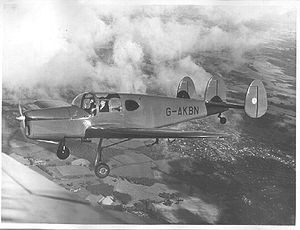Miles Messenger Video - With Gemini and Tiger Moths
|
|
Miles Messenger
Messenger

Picture - Miles M.38 Messenger 2A
Role: Liaison
Manufacturer: Miles Aircraft
First flight: 12 September 1942
Primary user: Royal Air Force
Produced: 1942-1948
Number built: 93
Developed from: Miles M.28 Mercury
The Miles M.38 Messenger is a British four-seat liaison aircraft built by Miles Aircraft.
Design and development
The Messenger was designed to meet a British Army requirement for a robust, slow speed, low maintenance, air observation post and liaison aircraft. The aircraft designed was a cantilever low-wing monoplane with fixed tailwheel powered by the de Havilland Gipsy Major 1D in-line engine. The prototype was converted from a Miles M.28 Mercury and first flew at Woodley on 12 September 1942. The aircraft had a good short field performance but only a small order was placed by the British Royal Air Force for the Messenger I as a VIP transport plane.
Wartime users of the aircraft included Field Marshal Sir Bernard Montgomery and Marshal of the RAF Lord Tedder.
After the war the Messenger 2A was built for the civilian market. The production aircraft were built at Newtownards in Northern Ireland and flown to Woodley for final fitting out. After 71 aircraft were built production of the aircraft ceased in 1948.
During the war a prototype aircraft was built as the M.48 Messenger 3 with fully retractable flaps. The model was not further developed as it did not provide any advantage over the other variants.
When the RAF retired surviving aircraft in 1948 they were in good condition and were converted for civilian use as the Messenger 4A.
The aircraft was a popular touring and racing aircraft during the late 1940s and early 1950s. In 1954 Harold Wood won the King's Cup Race air race at 133 mph.
Variants
Messenger 1
Military production aircraft for the RAF (21 built)
Messenger 2A
Civil version powered by the Blackburn Cirrus Major 3
Messenger 2B
Civil version powered by the Blackburn Cirrus Major 3
Messenger 2C
Civil version powered by the de Havilland Gipsy Major 1D
Messenger 3
Modified civil version powered by the Blackburn Cirrus Major 3
Messenger 4
Civil version powered by the de Havilland Gipsy Major 1D
Messenger 4A
Civil version powered by the de Havilland Gipsy Major 1D
Messenger 4B
Civil version powered by the de Havilland Gipsy Major 10
Messenger 5
Civil version powered by the Blackburn Bombardier 702
Operators
United Kingdom
Royal Air Force
Specification (Messenger 2A)
General characteristics
Crew: one, pilot
Capacity: three passengers
Length: 24 ft 0 in (7.32 m)
Wingspan: 36 ft 2 in (11.03 m)
Height: 7 ft 6 in (2.29 m)
Wing area: 191 ft² (17.75 m²)
Empty weight: 1,450 lb (659 kg)
Max takeoff weight: 2,400 lb (1,091 kg)
Powerplant: 1x— Blackburn Cirrus Major 3 4-cylinder air-cooled inline engine, 155 hp (116 kW)
Performance
Maximum speed: 135 mph (219 km/h)
Service ceiling: 16,000 ft (4,878 m)
Rate of climb: 950 ft/min (290 m/min)
Bibliography
Amos, Peter. and Brown, Don Lambert. Miles Aircraft Since 1925, Volume 1. London: Putnam Aeronautical, 2000. ISBN 0-85177-787-0.
Brown, Don Lambert. Miles Aircraft Since 1925. London: Putnam & Company Ltd., 1970. ISBN 0-37000-127-3.
Jackson, A.J. British Civil Aircraft since 1919. London: Putnam & Company Ltd., 1974. ISBN 0-370-10014-X.
Mondey, David. The Hamlyn Concise guide to British Aircraft of World War II. London: Chancellor press, 2002. ISBN 1-85152-668-4.
Miles Messenger Pictures and Miles Messenger for Sale.
Living Warbirds: The best warbirds DVD series.
Source: WikiPedia